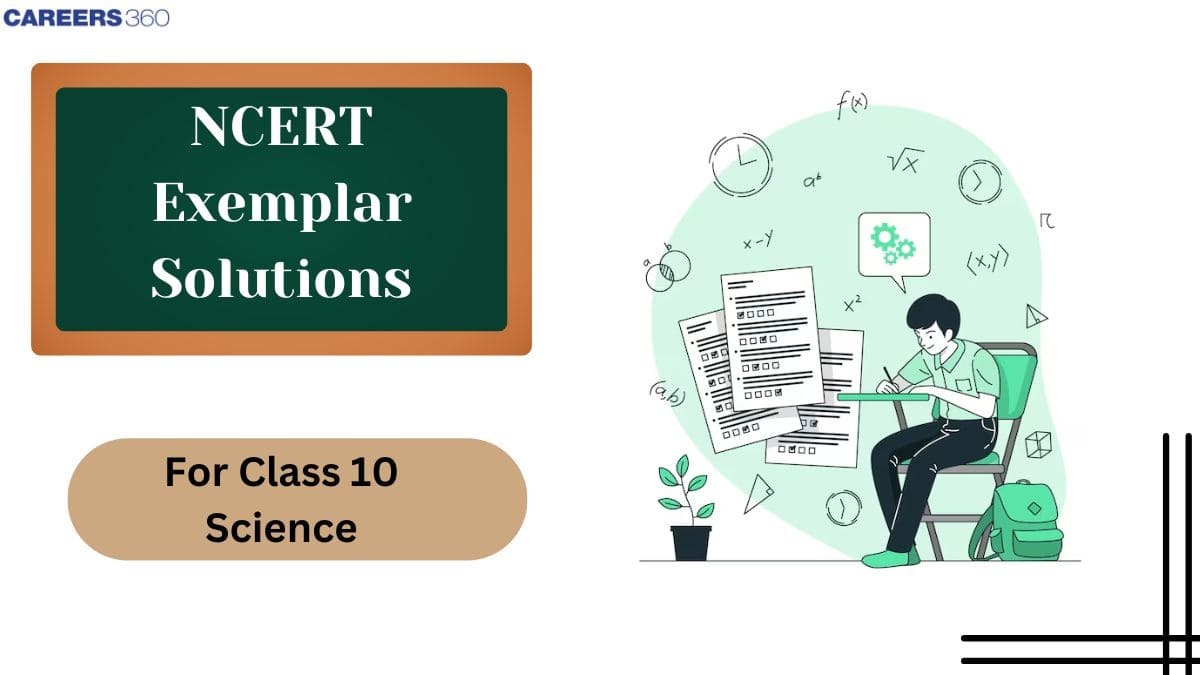Aakash Repeater Courses
ApplyTake Aakash iACST and get instant scholarship on coaching programs.
NCERT Exemplar Class 10 Science Solutions have advanced-level questions that provide a deep understanding of the fundamental concepts of science. They cover the chapters of the class 10 science syllabus, such as chemical reactions and equations, life processes, light, electricity, and more. They align with the latest CBSE syllabus and help students answer questions that require high-order thinking skills. They are necessary for improving their problem-solving skills and to prepare effectively for board exams and competitive exams.

The NCERT exemplar solutions provide a variety of objective-type questions and their answers to test the application of concepts in real-life scenarios. These exemplar solutions give an extra edge to the students while attempting the problems given in the science book. Subject experts have designed these answers in such a way that students will grasp the in-depth knowledge easily and effectively. Exemplar problems and solutions are sufficient to understand the Class 10 Science(CBSE level) and lay the foundation for competitive exams such as NIMO, NTSE, JEE Main, JEE Advanced, and NEET.
For Science, the NCERT Exemplar solutions include major topics in Physics, Chemistry, and Biology. The questions promote application-based reasoning and assist students in preparing for board exams as well as competitive exams. The solutions enhance the clarity of scientific concepts and enable students to develop confidence while answering various types of questions. Constant practice also helps in retaining crucial concepts and improving overall academic achievement.
These are the solutions that are specially made for students to manage their science problems. The problems are more complex compared to those that come in the regular textbook. Regular practice of these will allow students to improve their understanding, application level, and confidence in solving various types of questions. There are a reasonable number of questions in the NCERT Exemplar for all important topics in physics, chemistry, and biology that enable students to have a firm grip on scientific concepts. These examples are also very beneficial for students planning to score good marks in board exams or are preparing for future competitive exams.
The exemplar solutions for all the chapters in science are given below-
In Class 10 Science, Chapter 1 "Chemical Reactions and Equations" teaches students how substances change during chemical reactions and how to write and balance chemical equations correctly. It explains the importance of the Law of Conservation of Mass and helps identify signs of chemical changes, like color change, gas release, or heat. The chapter also introduces different types of reactions, such as combination, decomposition, displacement, and redox. With the help of NCERT Exemplar Solutions, students can practice a variety of questions, improve their understanding, and prepare better for exams.
Acids, bases, and salts are part of our everyday life—found in the food we eat, cleaning products, and even medicines. Chapter 2 of Class 10 Science, "Acids, Bases, and Salts," helps students understand the properties, reactions, and uses of these substances. It explains concepts like pH, indicators, neutralization reactions, and the formation of salts. The NCERT Exemplar Solutions offer well-structured answers that make complex topics easy to grasp, encourage logical thinking, and prepare students to solve a variety of exam questions with confidence.
Metals like iron and copper, and non-metals like oxygen and sulfur, play a vital role in our daily lives. Chapter 3 of Class 10 Science, "Metals and Non-metals," introduces students to the physical and chemical properties of these elements, how they react with other substances, and their various uses. This chapter also explains important concepts such as corrosion, reactivity series, and extraction of metals. The practice questions provided in this chapter help students build a strong base in the topic, improve their reasoning skills, and prepare effectively for exams through application-based learning.
Carbon is known for its ability to form a large number of compounds due to tetravalency. Chapter 4 of Class 10 Science, "Carbon and Its Compounds," introduces students to the structure, bonding, and properties of carbon-based substances like hydrocarbons, alcohols, and acids. It explains how covalent bonds work, why carbon forms long chains, and how these compounds are used in daily life. The questions in this chapter help students think critically, understand real-world applications, and prepare for exams in a clear and logical way.
The chapter on Periodic Classification of Elements in Class 10 Science explores how elements are systematically arranged based on their properties and atomic structure. It highlights the significance of the periodic table as a tool to predict element behavior and relationships among them. Students learn about trends such as atomic size, metallic and non-metallic character, and how elements in the same group share similar chemical characteristics. The exercises in this chapter encourage analytical thinking and help build a deeper understanding of chemical properties, aiding students in connecting theoretical concepts to practical observations.
Chapter 6, Life Processes, focuses on the fundamental activities necessary for living organisms to survive, including nutrition, respiration, transportation, and excretion. It explains how these processes differ in plants and animals and why they are essential for maintaining life. The chapter builds a clear understanding of biological functions through detailed examples. The exemplar solutions offer thorough answers to complex questions, helping students grasp important concepts and apply them confidently in exams. This practice also encourages analytical thinking and strengthens problem-solving skills.
Understanding how organisms coordinate their actions and respond to their surroundings is the focus of Chapter 7, Control and Coordination. This chapter explains the working of the nervous system and hormones in animals, and how plants show responses like tropisms. It highlights the importance of communication within living beings to maintain balance and function properly. The exemplar solutions offer well-explained answers to help students grasp these processes clearly and develop problem-solving skills essential for exams.
Chapter 8, How Do Organisms Reproduce?, focuses on the different methods by which living beings produce offspring to ensure the continuation of their species. It covers both asexual and sexual reproduction in plants and animals, explaining the processes involved and their significance. The chapter helps students understand the biological diversity and the role of reproduction in growth and survival. The exemplar solutions provide clear, step-by-step explanations to complex questions, enhancing comprehension and helping students prepare effectively for exams.
Chapter 9, Heredity and Evolution, talks about how living things pass on their features to their children and how they change slowly over a long time. It explains simple ideas like genes, differences between individuals, and how animals and plants evolve. This chapter helps students understand why we look like our parents and how life on Earth has changed. The exemplar solutions give easy answers to help students learn better and get ready for exams without confusion.
Light Reflection and Refraction, covered in Chapter 10, deals with how light changes direction when it hits different surfaces or passes through various substances. The chapter introduces the rules that explain why mirrors form images and why objects appear bent in water. It also discusses lenses and their uses in daily life. The exemplar solutions offer clear explanations and step-by-step guidance, helping students understand these concepts well and solve related questions with ease during exams.
Chapter 11, Human Eye and Colourful World, explains how the human eye works to help us see and how light interacts with objects to create colors. It covers the structure of the eye, common eye problems, and their corrections. The chapter also explores phenomena like dispersion, which explains why we see rainbows and colors in the world around us. The exemplar solutions provide easy-to-follow answers that strengthen understanding and prepare students for exams with confidence.
Electricity is a fundamental part of our daily lives, and Chapter 12 explains how electric current flows through different materials and circuits. It introduces key concepts like voltage, resistance, and Ohm’s law, helping students understand how electrical devices work safely and efficiently. The exemplar solutions provide clear and detailed explanations of problems, making it easier for students to grasp important ideas and excel in exams.
The chapter on Magnetic Effects of Electric Current introduces how electric currents can produce magnetic fields and how these effects are used in various devices. It explains concepts like electromagnets, magnetic fields around a current-carrying conductor, and the working of electric motors and generators. These solutions break down the concepts into simple explanations and practical examples, helping students build a clear understanding and apply what they learn confidently in their exams.
Energy is essential for all activities, and Chapter 14 explores the various natural and man-made sources from which we obtain energy. It covers conventional sources like coal and petroleum as well as renewable options such as solar, wind, and hydro power. The solutions explain these concepts clearly and encourage students to think about sustainable ways to meet our energy needs while preparing effectively for their exams.
The environment around us includes all living and non-living things, and Chapter 15 focuses on how they interact and depend on each other for survival. It covers topics like ecosystems, biodiversity, and the harmful effects of pollution and deforestation caused by human activities. The solutions provide detailed explanations that help students grasp these concepts clearly, encouraging them to develop a sense of responsibility towards protecting nature while gaining confidence for their exams.
Taking care of the Earth’s resources is crucial for our survival, and Chapter 16 highlights ways to manage natural resources such as water, forests, and minerals efficiently. It discusses the challenges of resource depletion and promotes sustainable habits to protect the environment. The solutions simplify complex ideas, helping students understand the importance of conservation and prepare well for their exams.
NCERT Solution for Class 10 Subject Wise
NCERT Notes for Class 10 Subject Wise
Also Check NCERT Books and NCERT Syllabus here
Yes, the number of questions provided in the NCERT exemplar are sufficient to prepare for examinations.
NCERT Exemplar questions are of good quality and provide the students with thinking and analytical skills that helps in the preparation of competitive exams.
The NCERT exemplar questions are different from the NCERT book questions. Exemplar questions give a good number of different types of practice questions and NCERT books gives questions to check conceptual clarity.

Take Aakash iACST and get instant scholarship on coaching programs.

This ebook serves as a valuable study guide for NEET 2025 exam.

This e-book offers NEET PYQ and serves as an indispensable NEET study material.

As per latest syllabus. Physics formulas, equations, & laws of class 11 & 12th chapters
As per latest syllabus. Chemistry formulas, equations, & laws of class 11 & 12th chapters
As per latest 2024 syllabus. Study 40% syllabus and score upto 100% marks in JEE